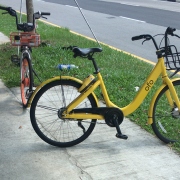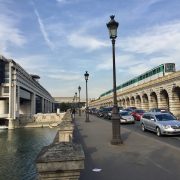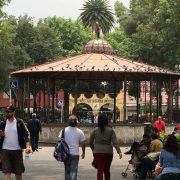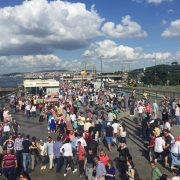Transit Tourism: Visiting Japan with Luskin’s Transportation and Urban Reform Study Group
By Tony Castelletto, MPP ’17
Not so long ago, I would not have considered myself a world traveler. This despite trips to Canada, Mexico, Scotland, and Greece. In all of these places, I’ve had at least one language in common with the locals. I don’t speak Greek, but most Greeks actually speak English quite well due to the sheer number of UK and US tourists visiting their country. Japan was a different story entirely. Many Japanese, of course, take English in high school. However, as most of us in the US can attest, passing your high school language courses does necessarily confer any great degree of fluency. Coming to Japan means stepping way out of your comfort zone as an American who only speaks English and Spanish. In Japan, you don’t even have an alphabet in common with the locals. The mark, then, of one’s status as a world traveler is getting from the airport to hotel without getting lost. This was where my adventure with Japan’s transit began.
The transportation group started its journey in Osaka. An old martial arts instructor of mine described Osaka as a suburb of Tokyo. As I was to find out, he was describing the relation between two cities, not their distance. Not knowing this until after I reserved my airline tickets, I flew into Narita Airport outside of Tokyo. I discovered that Osaka was about 350 miles from Narita Airport. Now here’s the test of a true World Traveler: getting from the airport to distant location on the local transit system with minimal or no preparation. I knew only that I had to get to Tokyo and that there was this miraculous thing called the Shinkansen that probably went to Osaka. Bleary eyed, I emerged from my thirteen hour flight to retrieve luggage and change my money into local currency. The next task was securing passage. Narita Airport is almost completely bilingual in the upper levels. Once you hit the ground transportation level, things change. That change, however, consists in the relocation of English on signs to the bottom and a reduction in font size for the lettering. The first stop was the train ticket office. The clerks were not completely fluent in English, but they made up for it with friendly service. The language barrier at the ticket counter constituted the longest delay of the entire trip, perhaps five minutes in total. I followed the signs to Airport Express platform. So far, the journey was not unlike anything I have currently experienced in Los Angeles. The train itself was fast, smooth, and spacious. I found myself thinking this Shinkansen thing was pretty good before I realized I had yet to set foot on the Bullet Train.
Tokyo Metro station, though, that’s where the casual traveler falls by the wayside. Not even NYC’s Grand Central Station can prepare any American for the press of crowds and the frenetic energy of Tokyo’s main rail station. For all the apparent chaos, a deep order abides under the surface. The people hurrying from one train to the next follow deterministic rules of physical motion. This experience demonstrates the design philosophy of the transit system. One finds affordances built into every aspect of the system. Signs are plentiful, informative, and accurate. They’re color coded, at least bilingual, and pervasive. I was able to navigate the station with ease, only stopping every now and again to ask transit guides if I was heading in the right direction. Along the floor, you see textured yellow tiles running in clear lines throughout the stations. Without even realizing it, I found myself walk along these yellow paths, instinctively cuing on their texture. I later found out that these textured tiles guide the blind through transit terminals. They also help the jet lagged foreigner.
Within ten minutes, I find myself waiting on the platform for the Shin-Osaka line. Five minutes later, an immense train looking more like an advanced jetliner shriven of its wings pulls quickly and quietly into the station. I board, entering into a passenger compartment that resembles no Amtrak or US regional rail train I have ever ridden. The compartment features spacious seats with an amount of legroom that I have not seen in airlines since the 1980s. This is the Japanese regional rail experience, a comfortable utilitarianism that gets you from place to place quickly with decent Wifi connectivity. The train accelerates smoothly and before I am quite aware of it, the landscape flies past as if I were in fact in an airplane flying terrifyingly close to the ground. We reached a cruising speed of around 170 mph. A bit more than two and half hours later we’ll be in Osaka. The entire trip from Narita to Osaka, a distance comparable to the distance between Los Angeles and San Francisco takes a bit under four hours even with the language barrier and train change at Tokyo.
This trip was not a vacation, it was an excursion in Urban Reform and Transportation Policy in Japan at both the local and national levels. My introduction into the substantive policy issues and frameworks came not from the meetings with government officials that took place throughout the trip. Rather, I gleaned a great deal watching the landscape fly past on the Shinkansen. The first thing I noticed was that Japanese cities are dense and vertical. Even small towns follow this pattern. During slower parts of the trip when we were pulling into stations, cycling was evident everywhere. While I saw that most detached homes had cars parked in driveways, they were not on the roads. The roads in the smaller cities and countryside were eerily empty from an American’s point of view. People have cars, but they don’t use them so much day to day. As I would find out later, this oversimplifies the story of transportation in Japan. Nonetheless, the major cities of the nation rely on their dense and wide ranging rail system for getting around their home city, visiting a friend the next city over, and in getting from end of the country to another. Once off the train, you navigate around your immediate area by walking. Even in Tokyo, one finds numerous pedestrian-only avenues. Commerce clusters in and around train and subway stations. If you can’t find it in a Tokyo subway station, it isn’t for sale, anywhere in the world. This rail connected network of commerce was, once again, by design. Before long, the Shinkansen slowed to a stop at my final destination, the Shin-Osaka Station with the hotel only a short walk away. The total length of the trip from airport to hotel was only about three and a half hours, perhaps a little longer. Over the next week, our hosts pulled back the curtain to show how the whole system works, revealing both the engineering and policy behind the systems we used.

Shinkansen locomotives at the Japan Rail Museum in Nagoya. The one of the left is the current model. All the way to right, you barely make out the first model.
Public Transportation Policy and Urban Reform are deeply entwined in Japan. Both have been crafted to address the same challenges, Japan’s declining birthrate and its aging population. In the next thirty years, Japan’s cities can expect their populations to decline between twenty and thirty percent. As the overall population declines, fraction of the elderly will increase as the population ages. At the same time, development in suburban areas has expanded with homes and stores being built farther away from metropolitan centers. This trend of suburban development when combined with population decline leads to severe financial strain on local governments as they struggle to provide services to increasingly widespread and older populations. Even the city of Tokyo has felt the impact as it slides on several key metrics of international competitiveness. While Tokyo and Japan remain prosperous and economically, viable, they have lost some of their previous vibrancy. In order to address the problems of shrinking population and to revitalize the economy, Japan has undertaken an ambitious program of urban reform.
This campaign has two components: Private Sector Urban Redevelopment and Compact City plans. The first seeks in increase the global competitiveness of Japan’s cities through public-private partnerships. This works by designating specific areas of cities as Urban Renaissance Districts. These districts offer special tax incentives and zoning variances for projects within the districts. The government can also offer loans at favorable terms to developers. The zoning variances include lifting of height restrictions for large, mixed use residential developments which provide more housing on a smaller footprint at affordable prices. This liberalized development strategy serves a purpose. These development plans serve the goal of drawing back urban sprawl and creating compact, network based cities. Many governments across the world have undertaken similar plans. Normally these urban plans aim to solve environmental problems and reduce emissions of Greenhouse Gases. For Japan, the Compact City also addresses its pressing economic and demographic challenges. The new development in and of itself stands to revitalize urban economies. Meanwhile, the network connecting public services and businesses in a small spatial footprint stands to reduce costs by creating new opportunities for residents while creating a more livable urban environment.
Transportation policy supports the Compact Cities plan by prioritizing new development along transit routes and through the creation of a denser transit network. As with other developed countries, Japan has a relatively high rate of private vehicle use which has created problems such as sprawl. Thus, the current transportation marks a departure from previous trends and is aimed at promoting more efficient use of urban space. To complement existing heavy gauge local rail and regional rail systems, MLIT has begun to develop and install light rail systems in its cities as well as expanding its bus systems. The focus here is supporting Transit Oriented Development to facilitate the Compact Cities plan. The overall policy addresses issues of access by creating both community buses to serve small cities and districts and on demand transit services for elderly and disabled citizens. In more rural regions, MLIT employs a hub model which connects the community transit systems of small towns and villages using regional transit. This ensures that rural residents can still access services despite declining population network and population density.

A street that’s also a mall in Kyoto. The city emphasizes walkability and community in its planning.
The logical question is whether these bold plans will work. How are they working now? In fact, MLIT’s Compact City and Transit Oriented Development plans represent a milestone on a developmental path undertaken in the 1990s as the nation grappled with serious urban pollution. The nation’s cities made conscious decisions to move rapidly away from the automobile. While Japan never adopted private vehicles to quite the same degree the US did, the move to the automobile created problems familiar to most Americans: sprawl, pollution, congestion. The government, working closely with its citizens undertook a major shift in priorities and planning.
The city of Kyoto exemplifies this trend as it redevelops to become more walkable and to modernize its public transit. With its citizens, city officials drafted a charter which redefined their identity as Japan’s premier historical city and described both what a livable city meant and the legacy they wanted to leave their children. This charter and its history provides a window into urban governance in Japan. Far from the top-down and hierarchical stereotype many American have of Japanese society, governance in the nation functions on a collaborative model. Local government officials cultivate deep ties with community groups and bring them in on the earliest stages of project planning to collect requirements and decide a project should actually do. The same sort of collaboration happens between the government and private firms.
In contrast to the US, private firms provide most of the transit services for the cities. The result of all these efforts, right now, is a dense and easy to use rail transit system that challenges many US assumptions about urban transportation. In transportation policy courses, we often talk about the tradeoff between mobility and accessibility. Mobility is that ability get where one wants to go whenever one wants to go there. In the US, that tends to mean a privately owned automobile. Accessibility refers to ability to afford or otherwise use modes of transportation. Accessibility encompasses issues of Socio-economic Status and Physical Disability among others. We tend to see Public Transit as providing accessibility. However, sitting in my car, jammed by traffic congestion on I-10, I find myself wondering how much mobility I actually have. In Japan, one might find oneself crammed cheek to jowl in a train car with one hundred best new friends during rush hour. However, you and your new best friends get where you’re going quickly and reliably. Access and Mobility? The Japanese seem to have both in a single transit system.
















